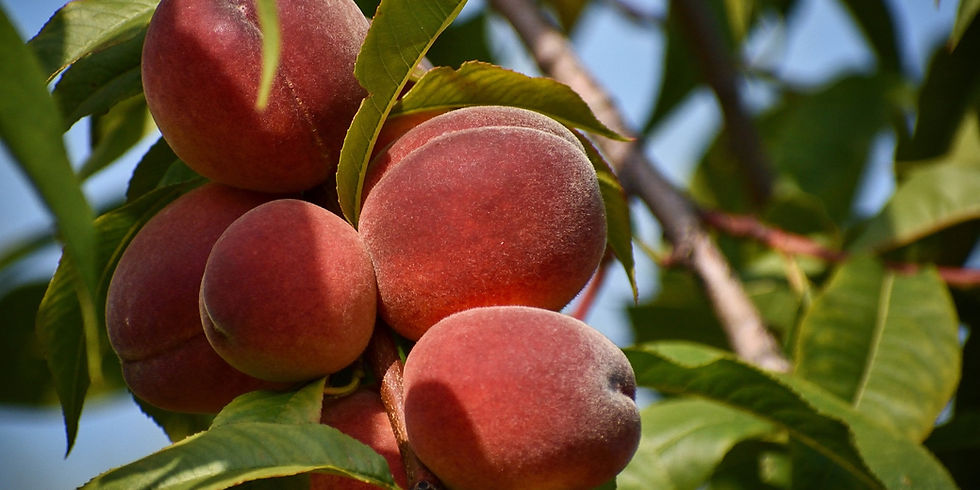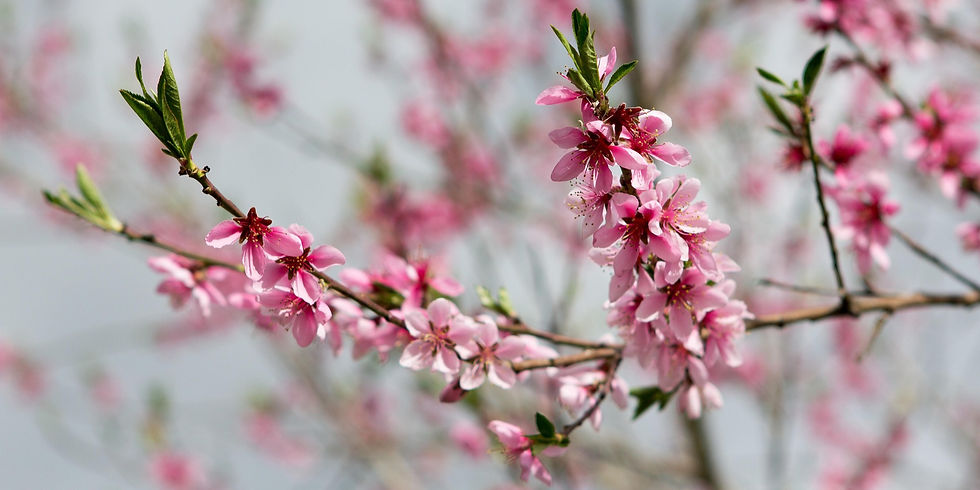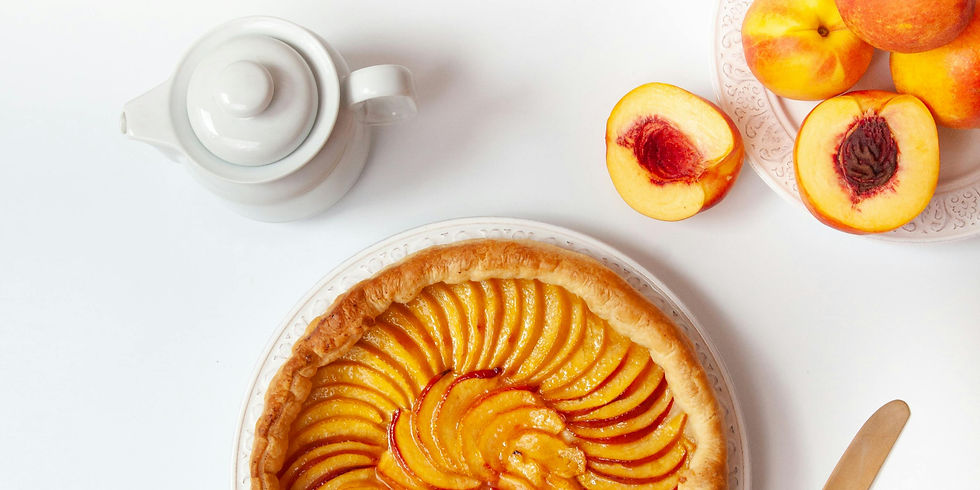Peach
- The Economic Botanist

- Aug 14
- 7 min read
Scientific name: Prunus persica (L.) Batsch
Family: Rosaceae

You probably know peach as that juicy, sweet fruit that screams summer. But there’s more to the peach than picnic baskets and cobblers—it’s a fascinating plant with deep roots (literally and historically), a complex botanical story, and plenty of uses beyond dessert.
In this Plant Compendium entry, we’ll dig into the peach from root to fruit. Whether you’re planting an orchard or just curious about what makes this fuzzy fruit tick, we’ll walk you through it step-by-step.
History of Peach
Peaches have been grown for thousands of years. Originally from northwest China, they were cultivated as early as 2000 BCE and celebrated in Chinese art, poetry, and medicine. Peaches made their way west via the Silk Road, eventually reaching Persia (modern-day Iran)—which is where the species name persica comes from.
By the time peaches landed in Europe, they were already prized for their sweet flavor and beautiful flowers. Spanish explorers brought them to the Americas in the 16th century, and today, peaches are grown across the world, from California to Italy to Georgia (which, fun fact, is not even the top U.S. producer anymore—California is!).
Botanical Description
Peach trees are small deciduous fruit trees, part of the rose family (Rosaceae). They’re closely related to plums, cherries, and almonds.
Roots: Peach trees have a moderately deep, fibrous root system. They benefit from well-drained soils and good air circulation underground. In clay soils, roots may suffer from poor oxygen availability, so raised beds or mounds can help.
Trunk and Branches: The trunk is typically short with broad, spreading limbs. Bark is gray-brown and smooth when young, becoming more furrowed with age.
Leaves :Long, lance-shaped, and finely serrated, peach leaves are usually 7–16 cm (3–6 in) long. They’re a rich green and alternate along branches. Leaves may turn red or yellow in the fall.
Flowers: Peach flowers bloom in early spring—often before the leaves emerge. They’re usually pink, five-petaled, and appear singly or in pairs. Blossoms are self-fertile, meaning one tree can bear fruit on its own.
Fruit: The peach fruit is technically a drupe—a fleshy fruit with a hard stone in the center. Skin can be fuzzy (peach) or smooth (nectarine, which is a variety of the same species). Flesh ranges from yellow to white, and the taste is sweet, slightly acidic, and aromatic.
Seeds: Inside the stone (or pit) is a single seed. It's not typically eaten, and in large quantities, it can be toxic (more on that later).

Growing Instructions
Here’s how to get a peach tree growing and thriving:
Sunlight: Full sun is essential—aim for at least 6–8 hours a day.
Soil: Well-drained sandy loam is ideal. Avoid soggy soils, as peaches hate wet feet.
Temperature: Peaches need cold winters to set fruit but can’t handle extreme cold. They require chilling hours (usually 500–1,000 hours below 7°C/45°F) depending on the variety.
Watering: Regular watering is crucial, especially during fruit development. Deep water once or twice a week. Drip irrigation is best.
Spacing: Standard trees: 4.5–6 m (15–20 ft) apart.Dwarf trees: 2.5–3 m (8–10 ft) apart.
Pruning: Annual pruning is a must to maintain airflow, encourage fruiting, and manage tree shape. The “open center” or “vase” shape is popular.
Fertilizing: Use a balanced fertilizer (like 10-10-10) in early spring and mid-summer. Avoid late-season feeding that may trigger late growth vulnerable to frost.
Life Cycle: From planting to harvest, peach trees mature fairly quickly.
Germination: If starting from seed (less common), germination takes 2–3 months after stratification (cold treatment).
Vegetative Growth: Saplings grow rapidly, usually fruiting by year 3–4.
Flowering and Fruiting: Spring flowers lead to summer fruit, typically ripening June through August.
Dormancy: In fall, leaves drop and the tree rests until next spring.
Harvesting and Foraging
Harvesting
Peaches are ready to pick when:
The skin turns fully yellow or red, depending on the variety.
The fruit smells sweet and has a slight “give” when gently squeezed.
It easily detaches from the branch.
Pick by cupping the fruit and gently twisting. Handle with care—peaches bruise easily.
Foraging
Wild or feral peach trees can sometimes be found near abandoned homesteads or in warm climates. Always make sure they haven’t been sprayed with chemicals or growing in contaminated soil.
Plant Companions
Peach trees benefit from good neighbors:
Friendly companions:
Chives and garlic – repel pests like borers and aphids.
Nasturtiums – attract beneficial insects and deter aphids.
Dandelion – improve soil and attract pollinators.
Avoid planting near:
Tomatoes or potatoes – may carry diseases that affect peaches.
Walnut trees – release juglone, which can inhibit peach growth.
Common Pests and Diseases
Peach trees are a bit high-maintenance when it comes to pests and diseases:
Peach Tree Borer: Larvae that tunnel into trunks. Use pheromone traps and trunk wraps.
Aphids: Small sap-suckers. Spray with neem oil or introduce ladybugs.
Leaf Curl: A fungal disease that distorts leaves. Treat with copper-based fungicide in late winter.
Brown Rot: Causes fruit to decay. Prune for airflow and remove mummified fruit.
Scale Insects: Hard-shelled pests that attach to bark. Horticultural oils help control them.
Shopping Tips
Whether you're buying a tree or just peaches for snacking, keep these tips in mind:
If planting:
Choose disease-resistant, chill-hour-appropriate varieties for your climate.
Bare-root trees are ideal for planting in early spring or late winter.
Look for trees with strong central trunks and no signs of disease.
If buying fruit:
Peaches should smell fragrant and feel slightly soft when ripe.
Avoid rock-hard peaches (they were picked too early) or overly mushy ones.
Store ripe peaches in the fridge for 3–5 days—or let them ripen at room temp if firm.
Storage
Fresh Peaches: Keep at room temperature until ripe, then refrigerate. Use within a few days.
Freezing: Slice, remove pits, and toss with lemon juice to prevent browning. Freeze on a tray, then store in airtight bags.
Drying: Peach slices can be dehydrated and stored in airtight containers for snacks or baking.
Canning: Peaches can be preserved in syrup or juice. Always follow safe canning guidelines.

Culinary Uses
Peaches are truly a kitchen superstar, lending their sweet, juicy flavor and delicate aroma to an incredible variety of dishes. Whether fresh, cooked, or preserved, peaches bring a burst of sunshine to your meals. Here’s a deep dive into how you can enjoy peaches at their best:
Fresh Eating
Nothing beats biting into a perfectly ripe peach—sweet, juicy, and fragrant. Fresh peaches are great as a snack on their own, sliced into fruit bowls, or added to smoothies and yogurt parfaits for natural sweetness and nutrition.
Salads
Peach slices add a lovely pop of color and a sweet contrast to savory greens. Try pairing fresh peaches with arugula, spinach, or mixed greens, along with nuts like pecans or almonds, tangy cheeses like feta or goat cheese, and a light vinaigrette for a refreshing summer salad.
Grilling and Roasting
Grilled peaches develop a smoky caramelization that’s hard to resist. Halve and pit the peaches, brush them lightly with olive oil or honey, then grill for a few minutes on each side. Serve them as a side with grilled meats or as a dessert topped with ice cream or whipped cream. Roasted peaches, especially with a drizzle of balsamic vinegar or sprinkled with cinnamon, make a warm, cozy treat.
Baking and Desserts
Peaches are a classic ingredient in pies, cobblers, crisps, and tarts. Their juicy flesh softens and sweetens beautifully when baked. Peach cobbler, with its buttery biscuit topping, is a Southern favorite. Peach ice cream, sorbets, and jams capture the fruit’s essence for year-round enjoyment. Try baking peaches stuffed with nuts, honey, and spices for an elegant dessert.
Preserves and Canning
Peaches preserve beautifully as jams, jellies, or canned slices. Homemade peach preserves capture the sweet summer harvest and make wonderful gifts or pantry staples. Peach jam spreads well on toast, swirled into oatmeal, or dolloped onto pancakes.
Beverages
Peaches brighten drinks in many forms. Fresh peach slices or puree add flavor to iced teas, lemonades, and cocktails like bellinis or sangrias. Peach-infused water is refreshing and hydrating on hot days. You can also make peach smoothies by blending peaches with yogurt, honey, and a splash of juice or milk.
Sauces and Salsas
Cook down peaches to create sweet sauces that pair wonderfully with pork, chicken, or fish. Peach salsa, made by combining diced peaches with tomatoes, onions, jalapeños, and cilantro, is a vibrant topping for grilled dishes or tortilla chips.
Peaches’ versatility in the kitchen makes them a beloved fruit year-round—whether fresh and simple or cooked into gourmet dishes, they bring natural sweetness and a bit of summer magic to your plate.
Health Benefits
Peaches are more than just tasty:
Vitamins and Minerals: Rich in vitamin C, vitamin A, potassium, and fiber.
Antioxidants: Contain polyphenols and carotenoids that support cell health.
Hydration: High water content makes peaches great for staying hydrated.
Digestive Support: Fiber helps support digestion and regularity.
Skin and Eye Health: Beta-carotene converts to vitamin A, promoting healthy vision and skin.
Toxicity and Safety
Peach fruit is safe for almost everyone. A few safety notes:
Pits/Seeds: Contain amygdalin, which can release cyanide in large amounts. Do not eat them.
Allergies: Rare, but some people may be sensitive to peach skin or flesh, especially if allergic to birch pollen.
Pesticides: Conventionally grown peaches can carry pesticide residues. Wash thoroughly or buy organic if concerned.
Environmental Impact
Peach trees can be surprisingly eco-friendly:
Pollinator-friendly: Their early spring blooms support bees.
Carbon storage: As perennials, peach trees help store carbon in wood and soil.
Erosion control: Their roots help anchor soil and prevent runoff.
Local food systems: Growing your own or buying local peaches reduces the carbon footprint of shipping.
One caveat: Commercial peach production can be resource-intensive (especially in water use), so choose sustainable growers when possible.




Comments